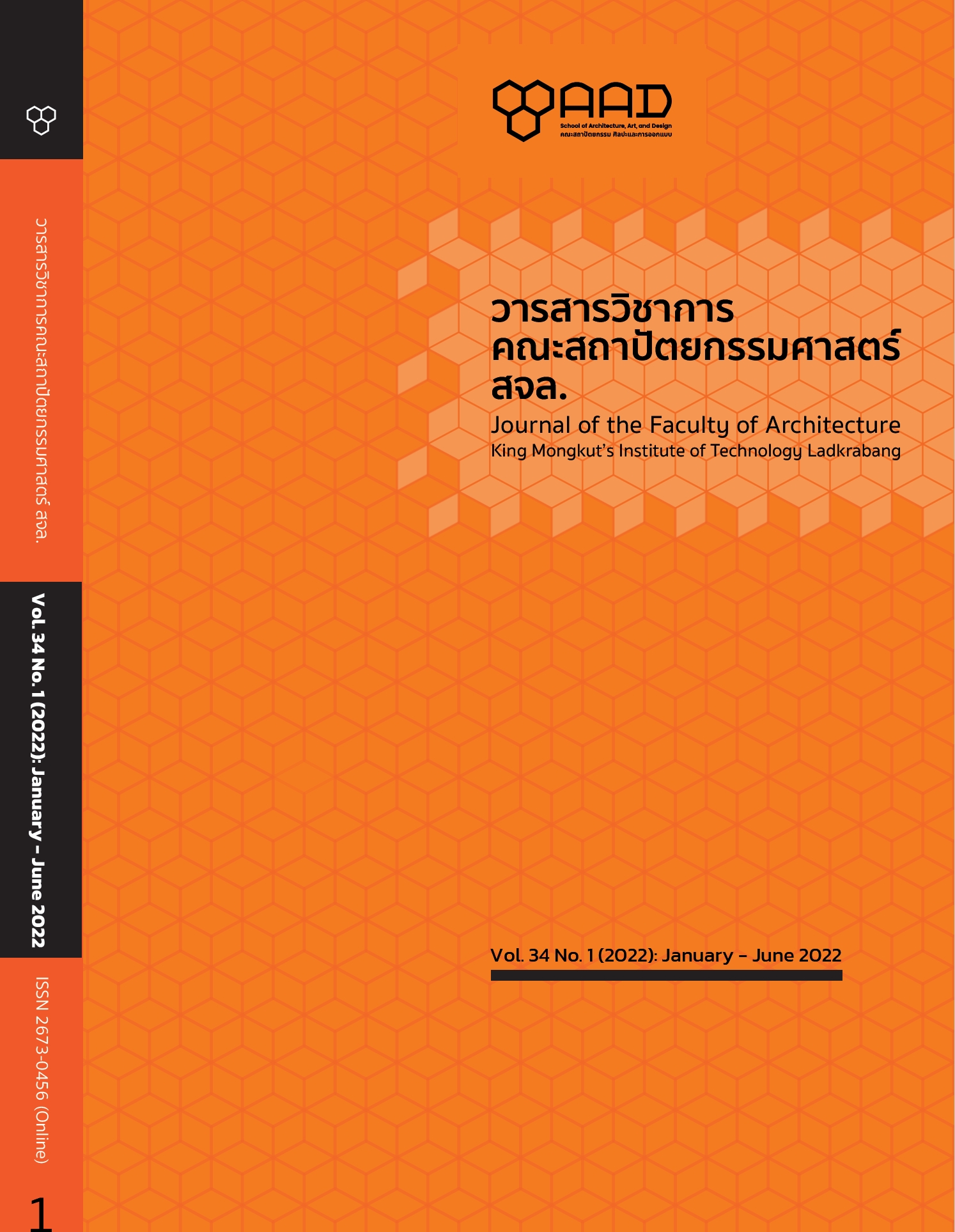แนวทางการออกแบบพื้นที่พักหรือพิงภายในที่พักอาศัยจากการสำรวจ ความเมื่อยล้าของผู้สูงอายุขณะใช้เป้อุ้มเด็ก 6-18 เดือน
Main Article Content
บทคัดย่อ
งานวิจัยนี้มีวัตถุประสงค์ คือ 1) เพื่อศึกษาพฤติกรรมที่เกิดจากอาการเมื่อยล้าขณะใช้เป้อุ้มเด็กภายในที่พักอาศัย
2) เพื่อสำรวจข้อมูลพื้นที่พักหรือพิงจากอาการเมื่อยล้าของผู้สูงอายุภายในที่พักอาศัย และ 3) เพื่อนำเสนอแนวทางการออกแบบพื้นที่พักหรือพิงภายในที่พักอาศัยขณะใช้เป้อุ้มเด็กสำหรับผู้สูงอายุ ผู้วิจัยทำการเก็บรวบรวมข้อมูลจากกลุ่มตัวอย่างผู้สูงอายุ 60 ปีขึ้นไป อาศัยอยู่ภายในเขตลาดกระบัง เขตสะพานสูง และเขตมีนบุรี จำนวนเขตละ 10 คน รวมทั้งสิ้น 30 คน และคัดเลือกอาสาสมัครผู้สูงอายุจากความสมัครใจจากเขตลาดกระบัง เขตสะพานสูง และเขตมีนบุรีเขตละ 1 คน ทั้งหมดจำนวน 3 คน โดยเก็บข้อมูลจากการสำรวจพื้นที่พักอาศัย ได้แก่ การใช้แบบสัมภาษณ์และแบบสำรวจ เพื่อทำการวิเคราะห์และสังเคราะห์ข้อมูลจากพฤติกรรมขณะใช้เป้อุ้มเด็กภายในที่พักอาศัยของผู้สูงอายุ
ผลการวิจัย พบว่า 1) ผู้สูงอายุมีพฤติกรรมการอุ้มเด็กด้วยท่าทางนำเด็กแนบอก และมักจะปวดเมื่อยบริเวณหน้าอก ไหล่ เข่า สะโพก และข้อเท้าขณะอุ้มเด็ก 2) ส่วนใหญ่ขณะที่ผู้สูงอายุเลี้ยงและอุ้มเด็กใช้เวลาอยู่ภายในห้องรับแขกมีขนาด (กว้าง*ยาว*สูง) ~3.5 – 5 เมตร x ~3.5 – 5 เมตร x 2.5 เมตร ภายในที่พักอาศัย และ 3) แนวทางการออกแบบพื้นที่พักหรือพิงควรจัดให้มีบริเวณสำหรับพิงเพื่อแบ่งเบาน้ำหนักตัวเด็กจากการเลี้ยงดูของผู้สูงอายุตลอดทั้งวัน และควรใช้วัสดุที่สามารถรองรับแรงขณะพักหรือพิง ได้แก่ โครงสร้างน้ำหนักเบาแข็งแรง วัสดุกรุโครงสร้างมีลักษณะนุ่มลื่น ระบายอากาศ ดูแลรักษาง่าย และใช้งานในระยะเวลาสั้น งานวิจัยในครั้งนี้สามารถนำไปต่อยอดทางด้านการออกแบบเฟอร์นิเจอร์ ผนัง และพื้นที่พักหรือพิงเพื่อพักผ่อนสำหรับผู้สูงอายุและคนทั่วไปในอนาคตต่อไป
Article Details

This work is licensed under a Creative Commons Attribution-NonCommercial-NoDerivatives 4.0 International License.
This work is licensed under a Creative Commons Attribution-NonCommercial-ShareAlike 4.0 International License.
Copyright Transfer Statement
The copyright of this article is transferred to Journal of The Faculty of Architecture King Mongkut's Institute of Technology Ladkrabang with effect if and when the article is accepted for publication. The copyright transfer covers the exclusive right to reproduce and distribute the article, including reprints, translations, photographic reproductions, electronic form (offline, online) or any other reproductions of similar nature.
The author warrants that this contribution is original and that he/she has full power to make this grant. The author signs for and accepts responsibility for releasing this material on behalf of any and all co-authors.
References
Atthawuttikul, A and Khongkarat, S. (2021). Factors in Ergonomic Design of 6-to-18-month Baby Carriers for Elderly People. Pertanika Journal of Science and Technology. 29(2), 1097-1108.
Bleah, D. A. and Ellett, M. L. (2010). Infant crying among recent African immigrants. Health Care for Women International. 31(7), 652-663.
Brown, M. B., Digby-Bowl, C. J., and Todd, S. D. (2018). Assessing infant carriage systems: ground reaction force implications for gait of the caregiver. Human factors. 60(2), 160-171.
Doris, S. F. Yu., Diana, T. F. Lee., and Ng, Wai. Man., (2009). Fatigue among older people: A review of the research literature. International Journal of Nursing Studies. 47(2), 216-228.
Ekparinya, A. and Fusakul, S. (2011). Tile Surfaces forms against impact in Bathrooms for Elderly People. Architecture Journal of King Mongkut’s Institute of Technology Ladkrabang. 12(1), 45-56.
For-Wey Lung, Bih-Ching Shu, Tung-Liang Chiang, and Shio Jean Lin. (2008). Efficient Developmental screening instrument for 6-and 18-month-old children in the Taiwan Birth Cohort Pilot Study. Acta Paediatrica Nurturing the Child. 97(8), 1093-1098.
Goertz, G. (2008). Concepts, Theories, and Numbers: A Checklist for Constructing, Evaluating, and Using Concepts or Quantitative Measures. Political Science, Political Methodology, Comparative Politics, The Oxford Handbook of Political Methodology, September 2009.
Pajoodtakae, C., Phumichanteak, A., & Srimeanwai, P. (2019). Situation and Factors Associated with Early Childhood Nutritional status In Regional Health Area 9. Regional Health Promotion Center 9 Journal. 13(31): May-August 2019, 159-177.
Heavens A. (2004). Boomers Trend Toward ‘Age-In-Place’ Housing 2004. Retrieved from: http://realtytimes.com/rtcpages/20011011_ageinplace.
Howe Ann, L. (2003). Housing and older Australia: more of the same or something different? 2003. Keynote address to the Housing Futures in and Ageing Australia Conference, Melbourne: Sponsored by AHURi and the Myer Foundation, November 2003.
Jendreck, M. P. (1993). Grandparents who parent their grandchildren: Effects of lifestyle. Journal of Marriage and Family. 55(3), 609-621.
Pattanapongtorn, J. (2018). Report of the Study of Factors Affecting the Development of Thai Early Childhood Children No. 6, 2017. Department of Health, Ministry of Public Health. pp. 9-44.
Okochi, J. Utsunomiya, S. and Takahashi, T. (2005). Health measurement using the ICF: Test-retest reliability study of ICF codes and qualifiers in geriatric care. Health and Quality of Life Outcomes, 29 July 2005: 3-46.
Spanbroek, N. (2005). Opinion: Design profession and ageing in place. Australasian Journal on Ageing. 24(2), 69-70.
Tongdi, N., Inwan, C., Proytong, S., Kaewlomkai, J. and Deepong, C. (2021). Muscle pain and risk factors of muscle pain during the online learning and working from home among the students and staffs of Faculty of Public Health, Thammasat University, Lampang Campus. Thai Journal of Ergonomics. 4(1), 47-57.

